Ghent: Belgium’s other canal city the perfect 9th anniversary escape
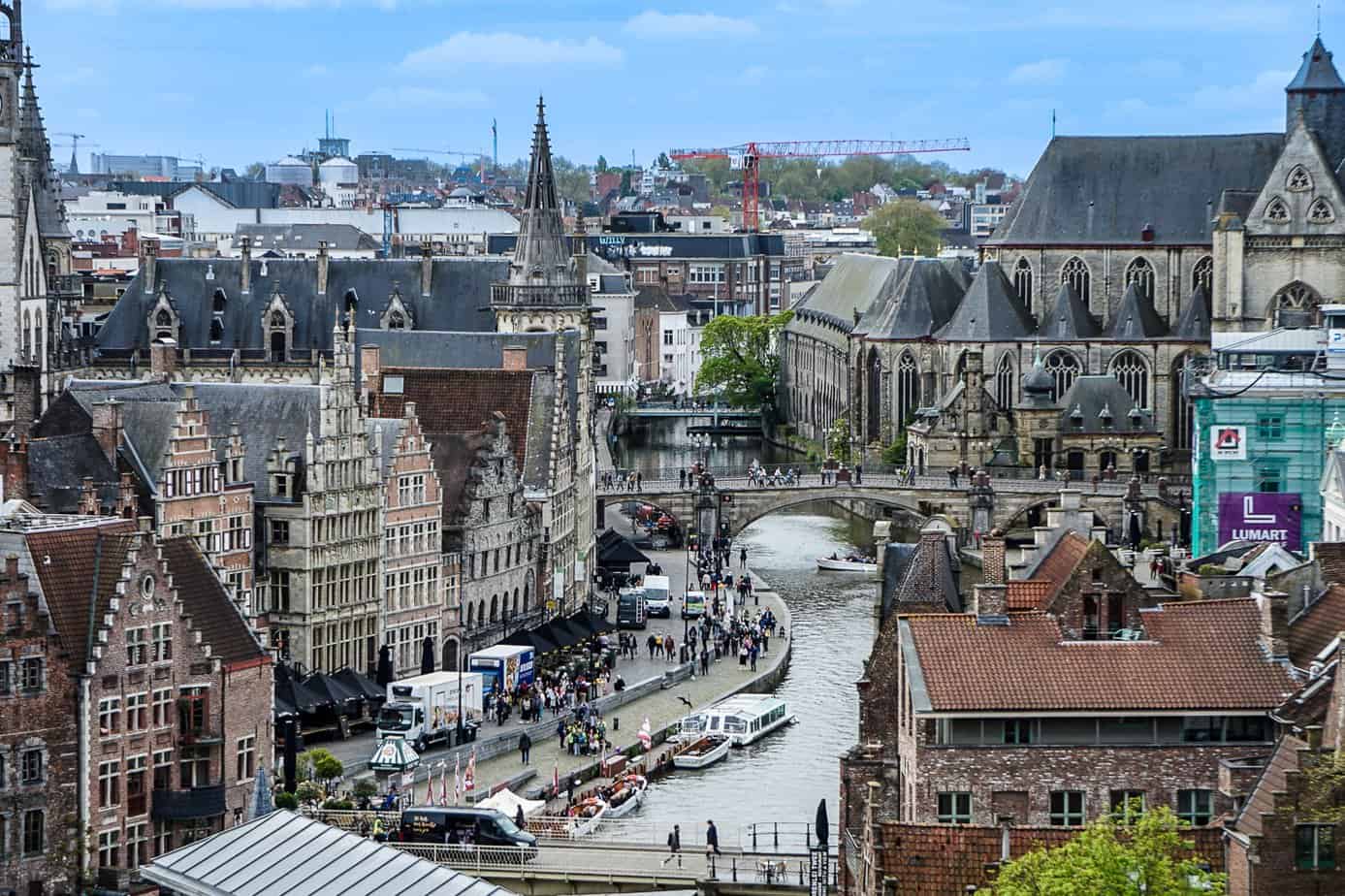
GHENT, Belgium – Anniversaries are usually a time for reflection. Marina and I, however, like to stay in the present. That’s how we use anniversaries. We go to places so beautiful, so memorable, that whatever wonderful events led us to that moment don’t overshadow what we’re experiencing at the time.
The places we’ve gone on quick weekend getaways in Italy to celebrate our first date drip with romance, like honey on a heart. Positano. Venice. Sardinia. Sicily.
This year we went abroad. It fits. In our nine years together, we’ve been to 26 countries, from Canada to Japan, from Norway to Lebanon. So to celebrate our magical April 29, we went to our favorite European country outside Italy and Greece.
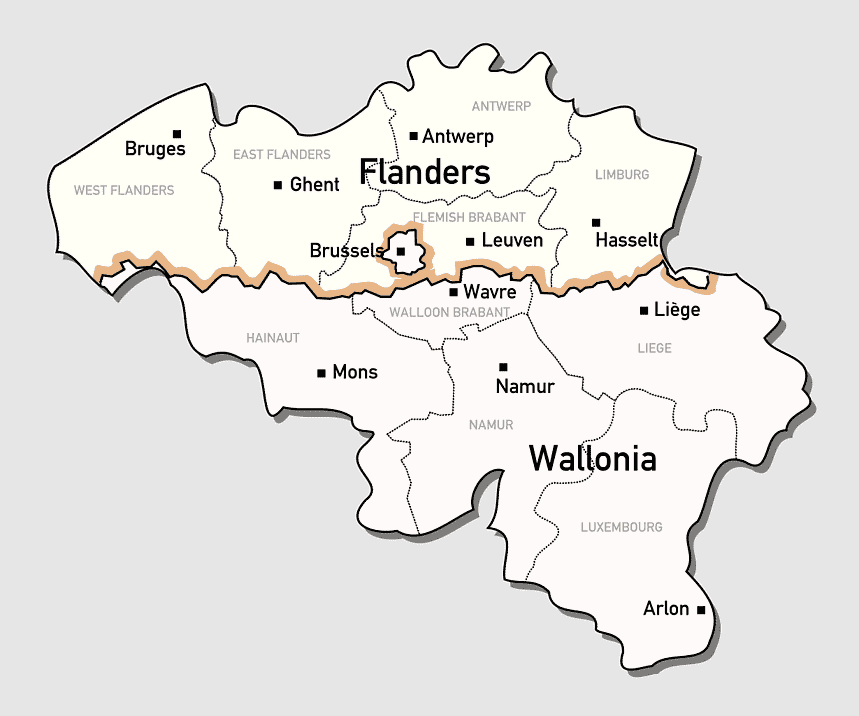
We fell in love with Belgium when we went to Bruges on a magazine assignment in 2017. The canals winding between medieval architecture. The best beer and chocolate in the world. The laughing, self-deprecating people.
I was always told Ghent is Bruges light. It doesn’t have the panache of its better-known neighbor 30 miles to the west but it also has fewer tourists, is bigger but less crowded. It also boasts a Marriott that used to be a brothel.
No one can say I’m not romantic.
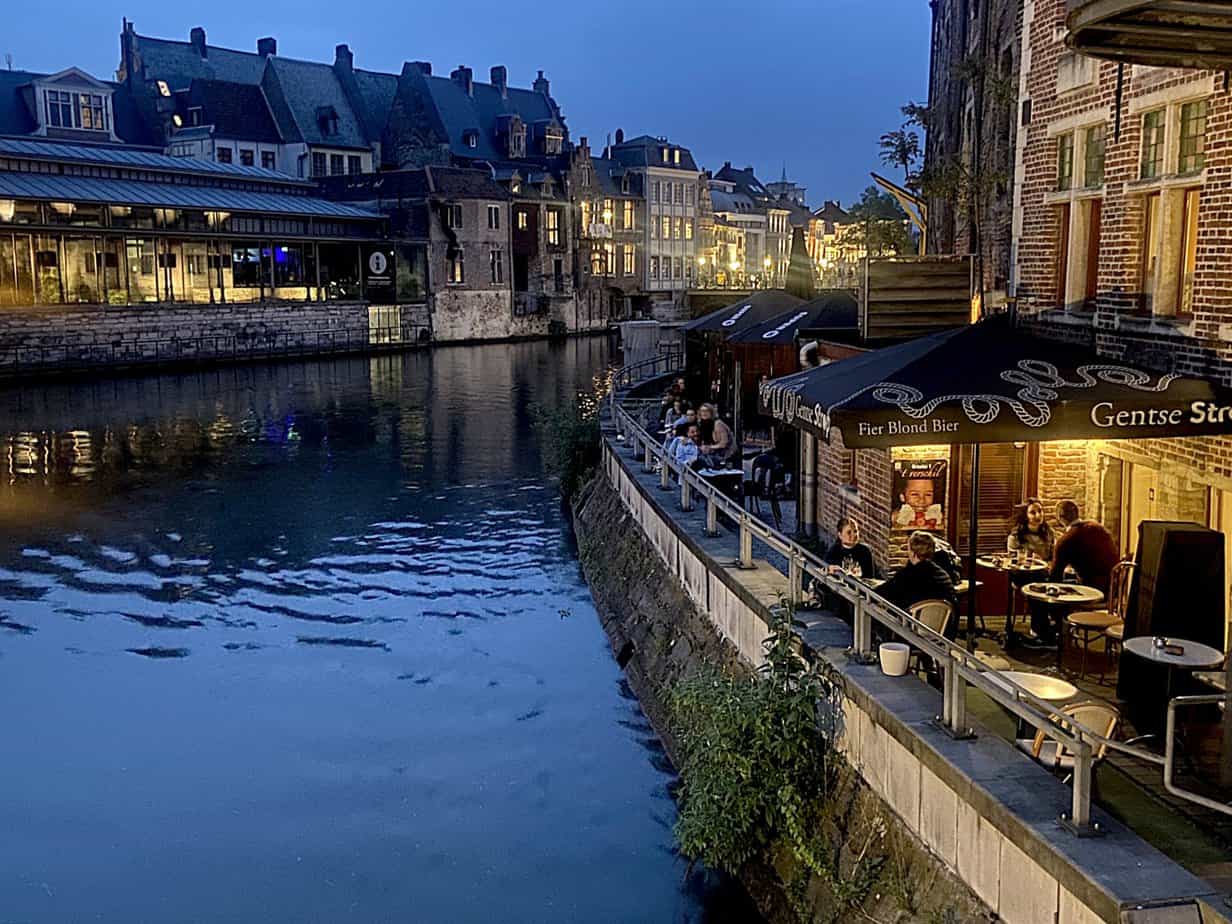
The arrival
Our anniversary got off to a jarring start. After our two-hour flight from Rome and the hour train from Brussels, we took a cab to our hotel. The Erasmus Hotel is on a quiet side street about 100 meters from the River Leie where boats have docked since the 11th century. The Leie remains the heartbeat of Ghent, where you sit in the sun drinking beer and gaze at jaw-dropping architecture out of A Knights Tale.
As Marina stepped out of the cab and slowly walked toward the hotel, she said, “Albergo sporco! (Dirty hotel!)” The Erasmus isn’t dirty. It’s just old. Real old. The building dates to the 16th century and looks it. The brick foundation is blackened from decades of passing cars. The wall of the upper floors looks as if it’s missing a few bricks.
As I checked in and told Marina she can handle all future hotel reservations – assuming we have another anniversary (I was angry) – things looked up. They gave us a free upgrade to a huge room with big windows looking out to a lush garden in the backyard. The yard’s flagstones date back to the Middle Ages. The elegant dining room where we ate an outstanding buffet breakfast, including eggs to order, featured a suit of armor, reflecting the town’s violent history.
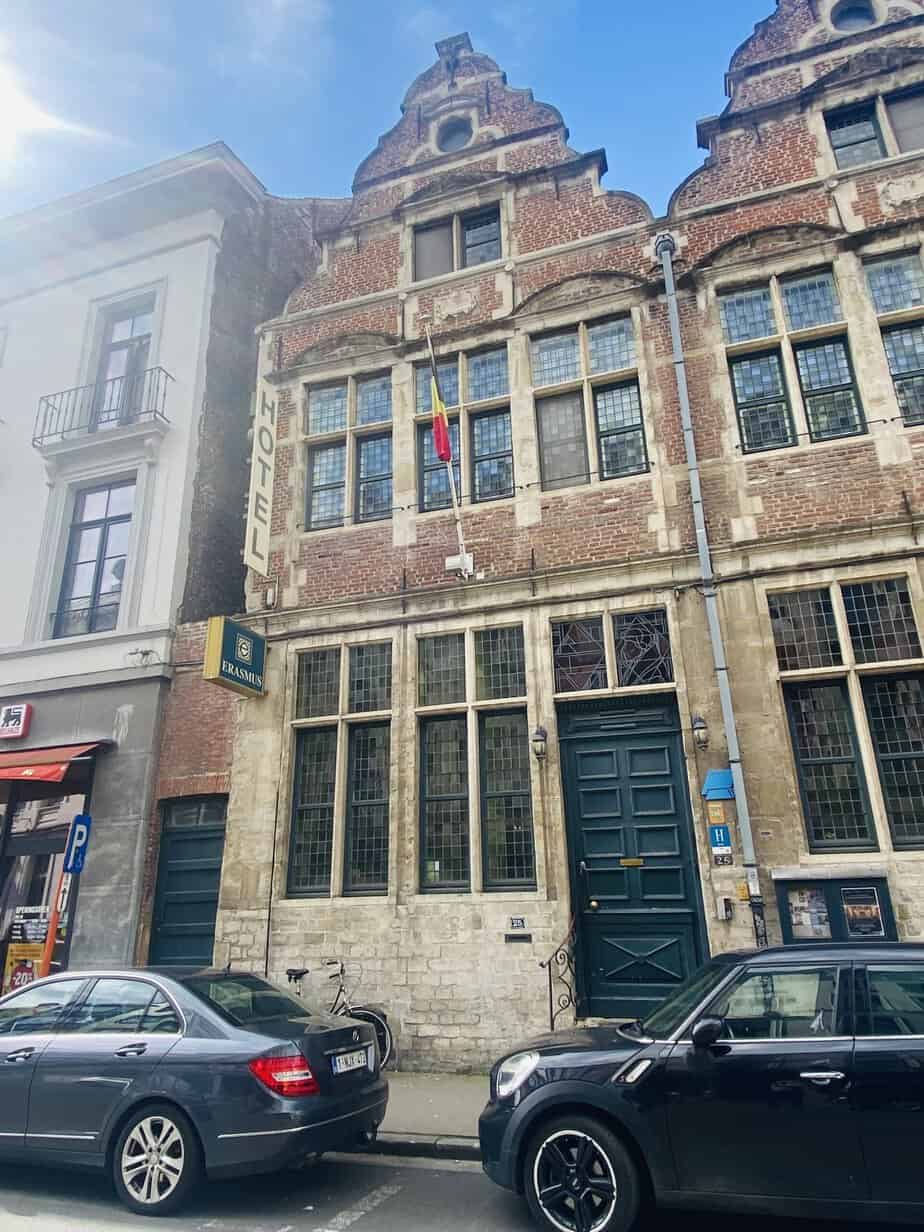
It looked like we stepped back in time four centuries. I felt like drinking scrog out of a wooden tankard and calling Marina “wench.”
Then we walked to the river and returned to modern Belgian tourism. Ghent gets 1.3 million tourists a year, about a third fewer than Bruges and most of those come during the wild 10-day Gentse Feesten (Ghent Festival) in July. We took a seat at a long string of bars along the side of the river called Korenlei and had our traditional welcome beer.
Lining the river’s boardwalk were purple, white and yellow flowers and small tables where people sipped drinks, talked, laughed and read. A woman from Antwerp working in foster care sat next to us working on her computer.

Talk about an office with a view. Across the river were buildings dating back to the Middle Ages with steep roofs of orange, red and white brick rising in steps to a point and churches with clock towers reaching toward the sky.
Belgians are so nice. They take themselves less seriously than the French and see the lighter side of life. As cyclist Lance Armstrong called Belgium during his heyday, “Such a funny, little country.”
I guess it’s easy to be happy when you have the best beer and chocolate (Look for my blog on my chocolate tasting next Tuesday) in the world and hardly anyone is fat. Everyone rides a bike. Obesity is rare. Belgium is 109th in the world in obesity (defined as more than 30 kilograms of body fat relative to height) at 19.8 percent. (U.S. is 10th at 41.64).
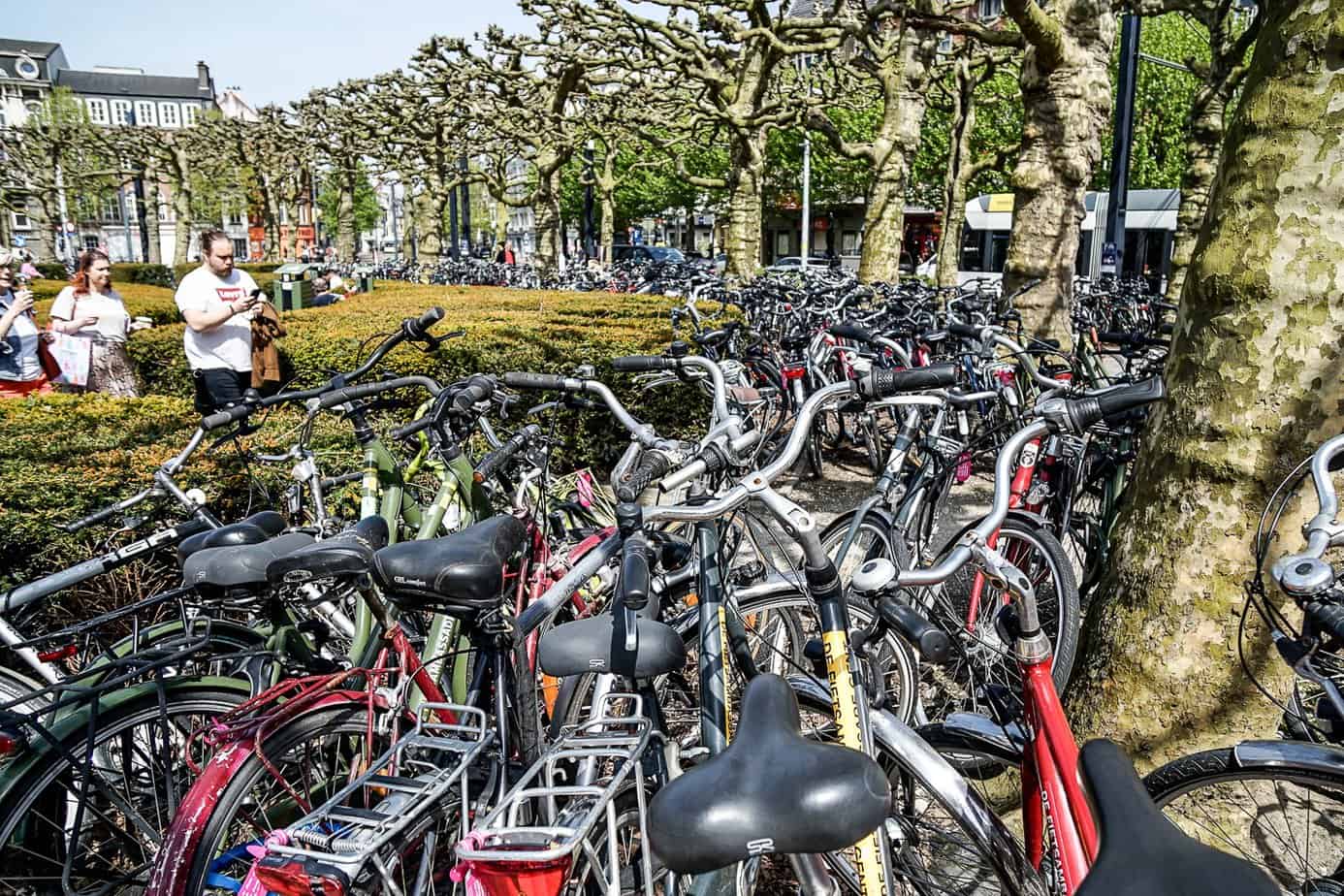
Ghent, Belgium’s second-largest city with 260,000 people, has the largest designated cycling area in Europe with 250 miles (400 kilometers) and 700 one-way streets. Ghent’s train station has spots for 10,000 bikes. Its large historical district has been car free since 2017 and in 2019-20 Ghent was a finalist for the European Green Capital Award.
At its peak in the 13th century, before the Bubonic Plague leveled much of Europe, Ghent was Europe’s leading cloth manufacturer. Boasting 65,000 people within its city walls, Ghent was the biggest city north of the Alps behind Paris. Then ruled by Spain, Ghent’s international cache fell during the 80 Years’ War when the Dutch revolted against Spanish rule, and the ensuing treaty collapsed trade.
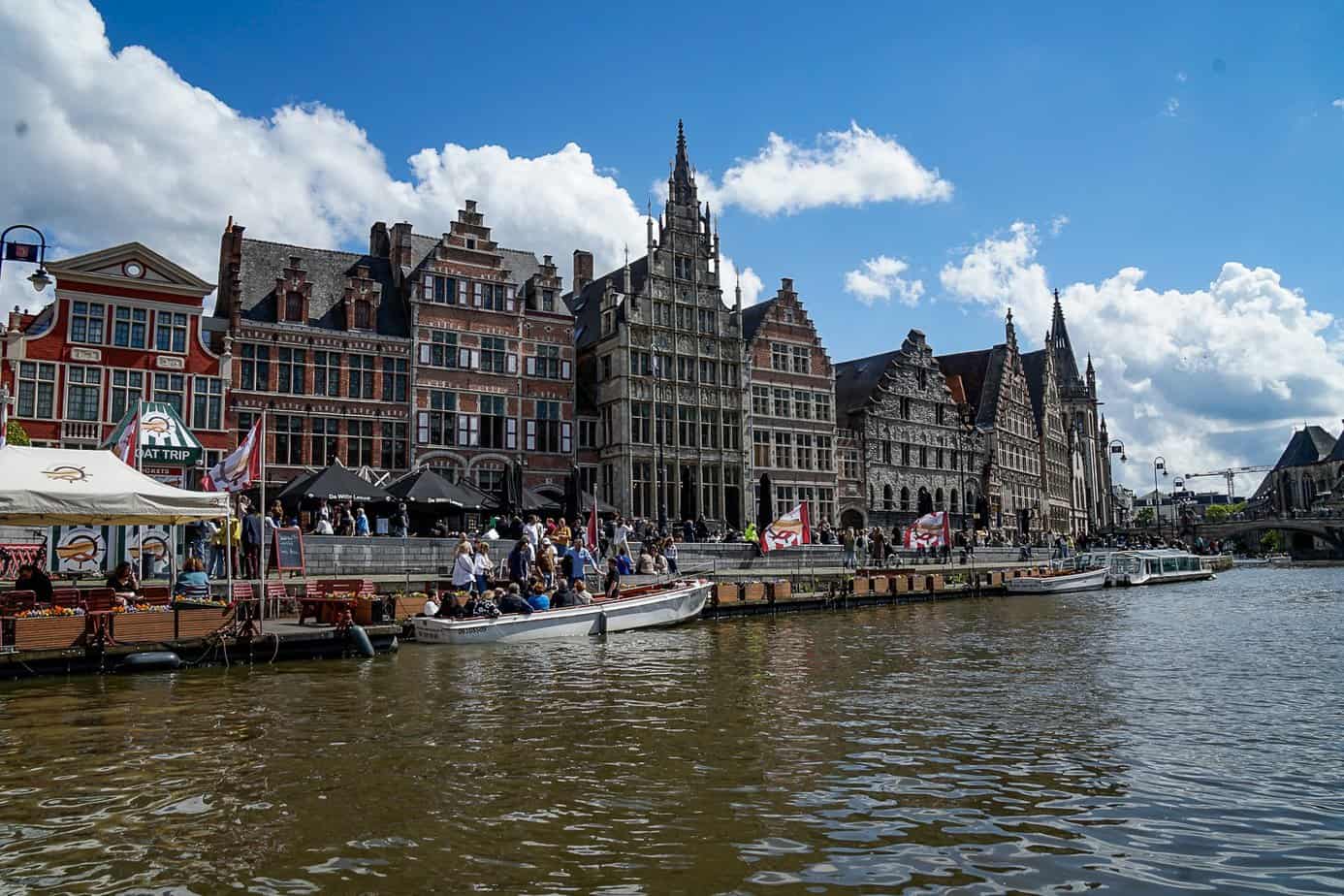
As we sat in the sun, small boats ferried tourists past those same beautiful buildings built during that economic boom period. As we did in Bruges, we took a canal cruise to orient ourselves to the city. Boat cruise stands line the river. They seemed to leave every 15 minutes and were always filled, even in the last week in April before the heavy tourist season.
Captaining and narrating the ride, in his 30s with a major tattoo on the back of his neck, was a typical amazing Belgian linguist. He spoke in English, French and Spanish – yet not in his native Flemish as no Belgians were aboard. There were also no Hmong so he didn’t speak that, either.

Ghent fun facts
We took seats in the middle and listened to fun facts about Ghent as we cruised the calm, narrow river on a sunny 64-degree afternoon:
- St. Nicholas Church, begun in the 13th century, stood out with its tower featuring five points surrounded by slender turrets. The guide explained that St. Nicholas was not only the father of Santa Claus but also the patron saint of prostitution. Which brings us to …
- … the Ghent Marriott. The modern entrance is actually just down the street from our hotel but the building’s original facing is still on the river. The brothel’s symbol remains on the wall: Two swans swimming away from each other, like a sailor and a hooker passing in the night.
- A long, gray-stone building stretched along one river bank. After it was built in 1328, it held the town fish and meat markets. Long abandoned, the city considered turning it into a bike parking lot. It makes sense. Belgium has the sixth-highest per capita bike ownership in Europe. It is at this building where many students who attend Ghent’s six universities get hammered and throw their bikes in the drink. The Leie is cleaned every five years. One year the city recovered 782 bikes.
- We passed the Bridge of Imperial Pleasures. Built in 2000, it features a boat at one end and is dedicated to Charles V, the Holy Roman Emperor and randy Hapsburg, the Austrian-based people who ruled the Spanish Empire, including Belgium, in the 1500s and 1600s. The guide said the Hapsburgs were known for incest and the consequential ugliness. He said when Charles V died, his lone remaining testicle was black. Many Hapsburgs died from incest, causing the guide to quip, “They literally screwed themselves out of existence.”
- Ghent has dozens of bridges and it’s very romantic to float under them or eat alongside them. But in the 1500s they were the scariest places in town. In 1540, Ghentians refused to pay taxes to fund Charles V’s military campaigns. He responded by making all protestors walk around with nooses around their necks. He eventually hanged 300 of them from the bridges we floated past. To this day, Ghentians are known as Stroppendragers (Rope Pullers), which they no doubt hear every time KAA Gent plays arch-rival FC Brugge in the Belgian league.
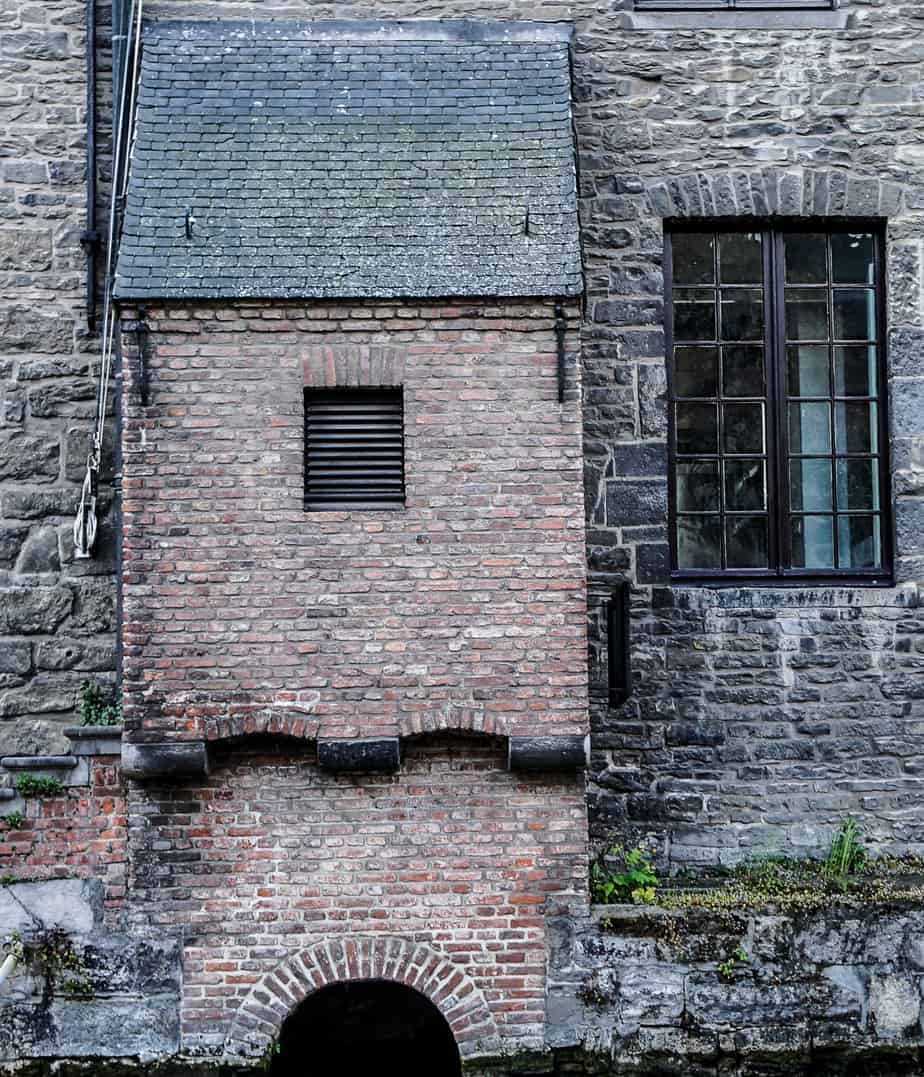
Many times we passed Gravensteen, arguably the biggest castle I’ve ever seen. One way to reach Gravensteen is to walk across what is still called Execution Bridge. From 1371-1585, it was the site of public beheadings for murderers and rapists.
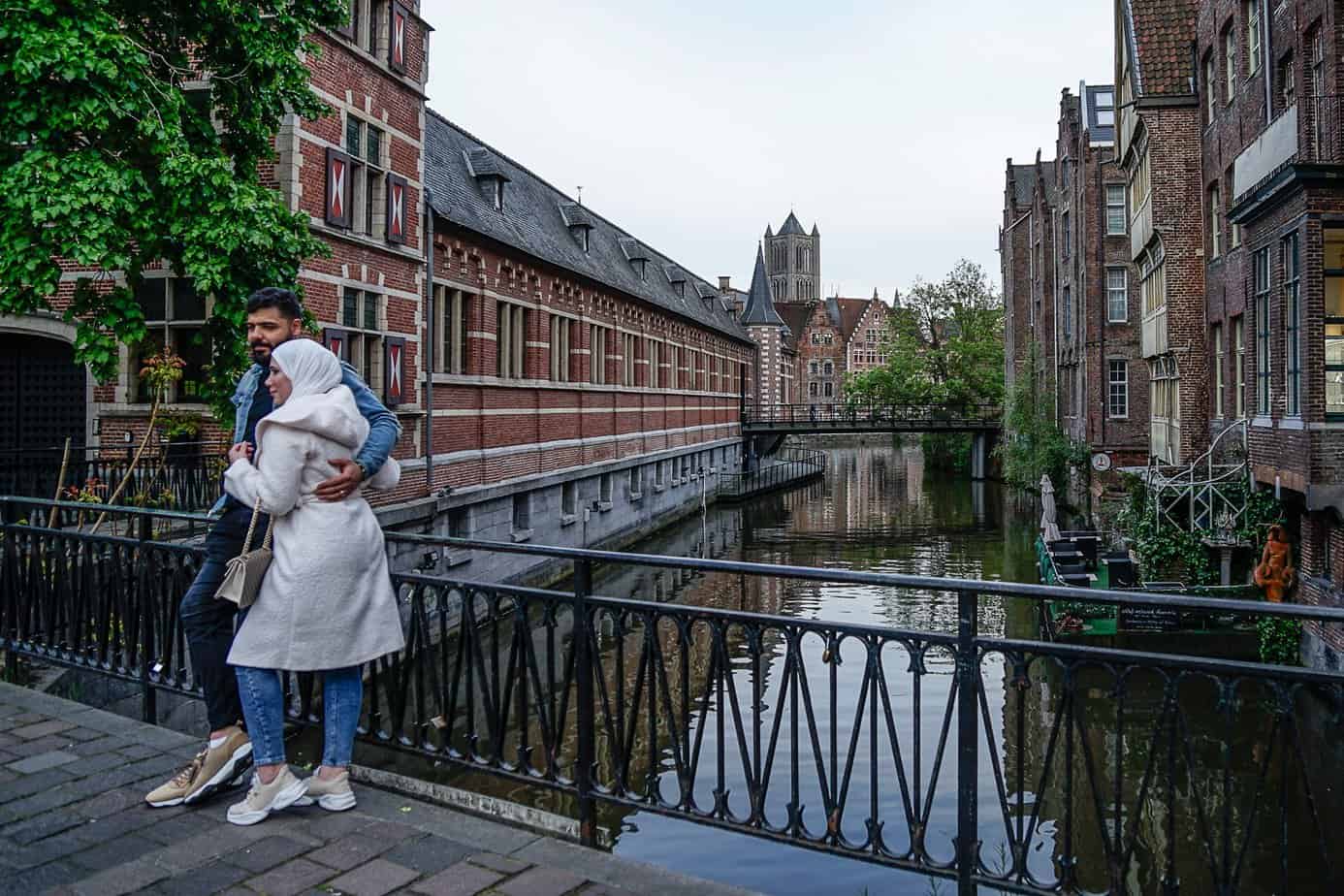
Gravensteen
The castle is massive. It’s a gray sandstone monolith peppered with high turrets for protection while shooting down at enemies. Built in 1180, it’s the fifth-oldest castle in Europe and was the home of the counts of Flanders until 1353. Since then it has been a prison, a mint and a cotton factory. Flanders’ black and yellow flag still flutters atop.
Included in the admission was an entertaining audio guide laced with biting Belgian humor. Near the entrance, you can look up and see slits at the top of the castle. That’s where they poured boiling oil on invaders, punctuated by the comical screams heard on the audio guide.

The castle was built for Count Philip at a time when expensive stone began replacing wood for home construction and he wanted to show off his wealth. Gravensteen means “stone castle.”
Rooms display suits of armor, broadswords the size of sculling oars and crossbows. A torture chamber, lit purposely dark and eerie, holds a rack, spiked shackles and arm and leg clamps. There’s even a pit where they threw prisoners and fed them, the guide said, “a moldy piece of bread every three days while fighting off rats.”
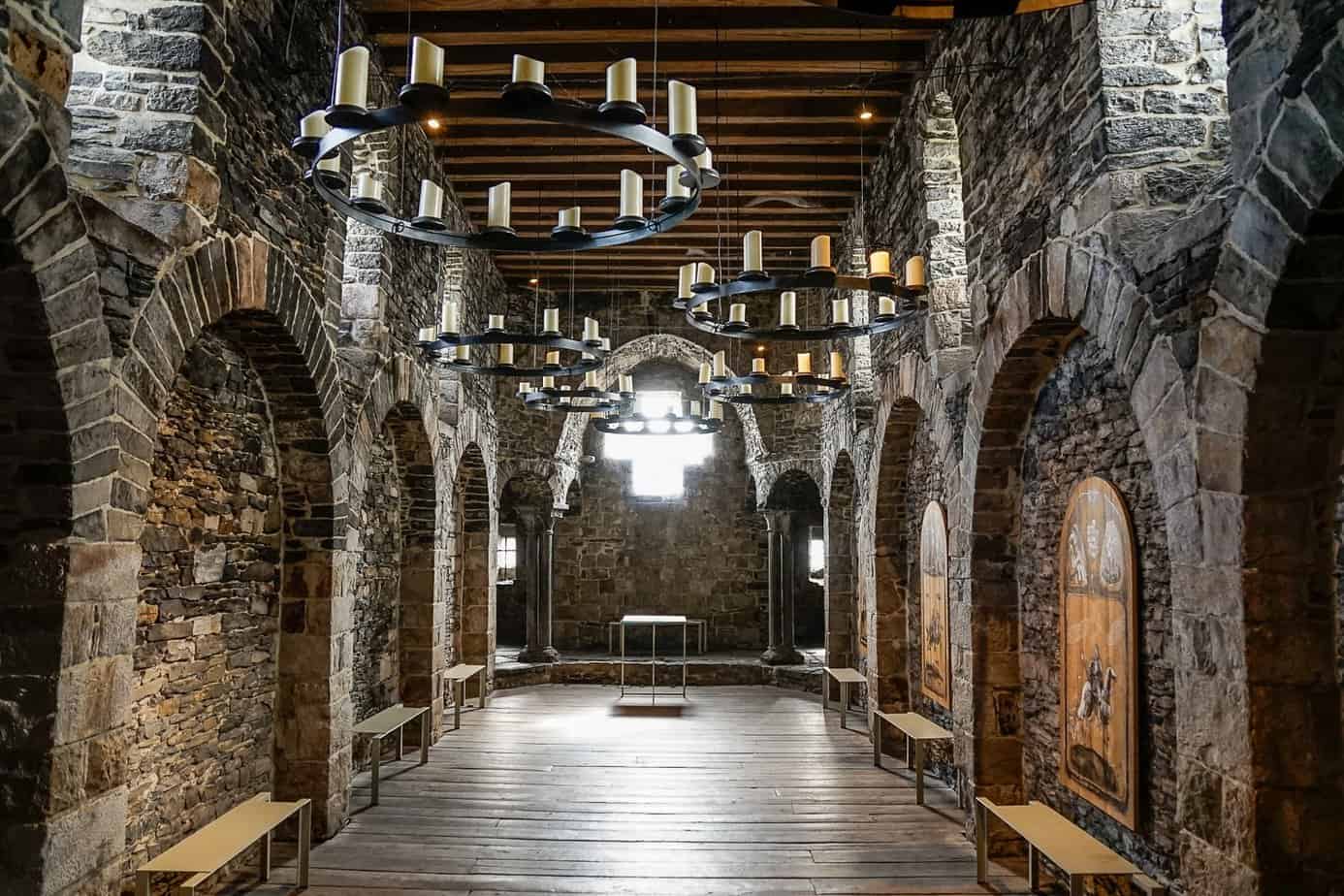
The place was crawling with school groups. Children wearing fake medieval vests ran around jousting each other and pretending to throw molten oil through the slits atop the castle. It’s worth the climb. Below us was a panoramic view of Ghent with the majestic Leie languidly snaking through the city.
Adoration of the Mystic Lamb
Ghent’s other major tourist attraction is a painting. Not a museum. A painting. One. By two Flemish guys I’d never heard of. It’s called the Adoration of the Mystic Lamb. It’s in St. Bavo’s Cathedral, towering 90 meters over the river and built in 942.
I was told to go early to avoid the huge lines that head into the darkened, temperature controlled chapel or check out the replica in a side chapel. To see the real thing is €12.50. That’s €12.50 to see one painting? Our Vatican Museums don’t overcharge like that.

The attraction of Mystic Lamb, however, isn’t just the quality. It’s the timing. The Van Eyck brothers painted it in 1432. That’s 60 years before Columbus discovered America. When I arrived, the line was short. I made my way through the gate and up the stairs to the chapel.
Turns out, the painting was worth every centesimo. It’s spectacular. It’s 12 separate panels, all glorifying Christ’s death. The colors are nearly 600 years old and they looked six hours old. They were blinding bright.
There are panels featuring nude Adam and Eve. There is God at the top flanked by Mary and John the Baptist. Below them, the centerpiece, is the lamb, representing Christ’s sacrifice, standing atop a red and white chest with its blood siphoning off into a well.
The painting’s history adds to the intrigue. The Calvinists, Protestant reformers, wanted it destroyed. Austrian emperor Joseph II was so horrified by the nude Adam and Eve he had the panels replaced with clothed versions, long since removed by saner minds. It went to Paris during the French Revolution and later the Germans stole it during World War II and hid it in an Austrian salt mine.

But the best part about Ghent is hanging out. If hanging out was a sport, Belgians would be world powers. Ghent’s large historical center only allows service cars. Cyclists ride through like it’s the Tour of Flanders.
On every block is a bar with many of Belgium’s 1,500 beers. At a small outdoor bar called Yo’s Place, I ordered a Kwak. Nearly every Belgian beer has its own glass aimed at maximizing the beer’s particular properties.
Kwak’s stands about a foot high, round at the bottom and top and connected by a narrow tube. It’s stabilized on a table by a wooden holder. I pulled the glass out of the handle, drank it and shoved it back into the holder. A Ghentian at the table next to me politely said, “Excuse me. You’re supposed to drink by holding the wooden holder. That way you don’t touch the glass and warm the beer. You don’t want warm beer.”
Yes, Belgians know beer.

Before our train back to Brussels, we stopped on the Leie at the restaurant De Zwarte Zee (The Black Sea) for a final beer. The Tripel Karmeliet, with 8.4 percent alcohol and founded in 1679, was named the World’s Best Ale at the World Beer Awards in 2008. We watched the boats ply the waters. We saw people eating waffles covered in whipped cream and chocolate in the sun.
Bruges? Your city rival is a worthy foe.

If you are thinking of going …
How to get there: Trains leave about every hour from Brussels Airport. The hour-long journey cost €18.80 one way.
Where to stay: Erasmus Hotel, Poel 25, 32-09-224-2195, www.erasmushotel.be, info@erasmushotel.be. Great location just five minutes from the bustling Korenlei area of the Leie. The hotel opened in 1991 but in a charming 16th century building with big rooms and a huge garden out back. I paid €244.40 for two nights, including an excellent buffet breakfast.
Where to eat: ‘t Vosken, St-Baafsplein 19, 32-09-225-7361, https://www.tvosken.be/enm, Brasserie@tvosken.be, 9 a.m.-11 p.m. Beautiful location between St-Baafsplein and the towering 91-meter Belfort belfry. ‘t Vosken, Flemish for “The Fox,” has been around 134 years and is so picky about Belgium’s famed mussels it only sells them when they’re in season from the end of June through September. I had a fabulous thick chicken soup full of vegetables called Gentse Waterzooi. I paid €56.50 for two of us.
‘t Klaverblad, Corduwaniersstraat 61, 32-09-225-6117, www.restoklaverblad.tk, restklaver@telenet.be, 6-10 p.m. Thursday-Saturday, Monday; noon-3 p.m., 6-10 p.m. Sunday. High-end, intimate dining with three candles at each table. Mains start at €25. I paid €103 for two including starters, dessert and wine. Hey, it was our anniversary.
When to go: Spring. Flowers along the river are in full bloom and it’s the driest period. Our three days were in the high 50s to mid-60s with just an occasional drizzle. Avoid November and December when average low is 38 and each month gets 13 days of rain. July and August are relatively mild with average highs in mid-70s but it’s very crowded.
For more information: Visit Ghent, St-Veerleplein 5, 32-09-266-5660, www.visit.gent.be, 10 a.m.-5 p.m.

